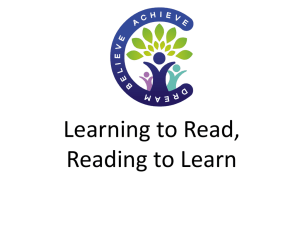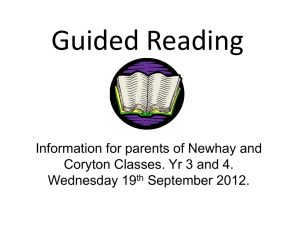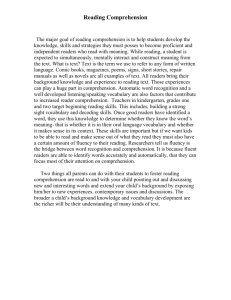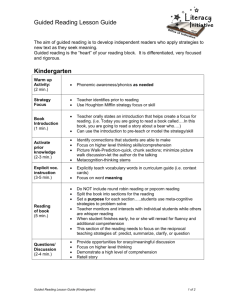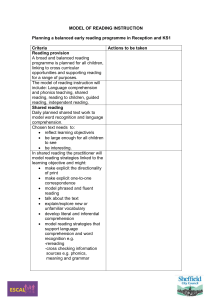Reading Strategies for Content Area Comprehension
advertisement
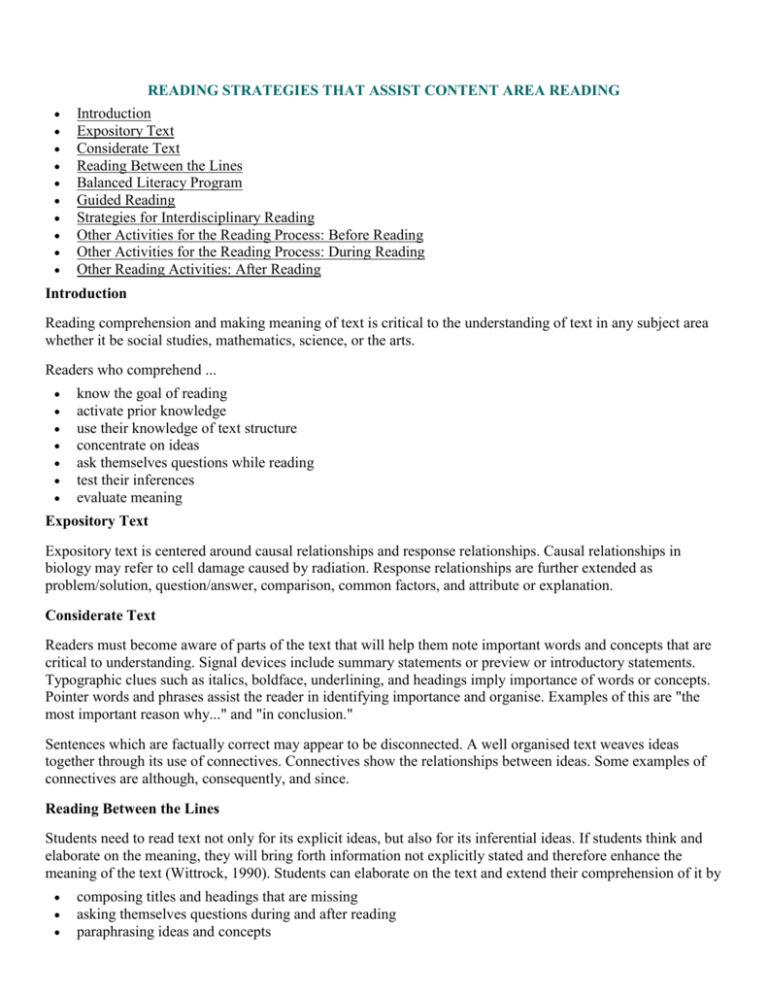
READING STRATEGIES THAT ASSIST CONTENT AREA READING Introduction Expository Text Considerate Text Reading Between the Lines Balanced Literacy Program Guided Reading Strategies for Interdisciplinary Reading Other Activities for the Reading Process: Before Reading Other Activities for the Reading Process: During Reading Other Reading Activities: After Reading Introduction Reading comprehension and making meaning of text is critical to the understanding of text in any subject area whether it be social studies, mathematics, science, or the arts. Readers who comprehend ... know the goal of reading activate prior knowledge use their knowledge of text structure concentrate on ideas ask themselves questions while reading test their inferences evaluate meaning Expository Text Expository text is centered around causal relationships and response relationships. Causal relationships in biology may refer to cell damage caused by radiation. Response relationships are further extended as problem/solution, question/answer, comparison, common factors, and attribute or explanation. Considerate Text Readers must become aware of parts of the text that will help them note important words and concepts that are critical to understanding. Signal devices include summary statements or preview or introductory statements. Typographic clues such as italics, boldface, underlining, and headings imply importance of words or concepts. Pointer words and phrases assist the reader in identifying importance and organise. Examples of this are "the most important reason why..." and "in conclusion." Sentences which are factually correct may appear to be disconnected. A well organised text weaves ideas together through its use of connectives. Connectives show the relationships between ideas. Some examples of connectives are although, consequently, and since. Reading Between the Lines Students need to read text not only for its explicit ideas, but also for its inferential ideas. If students think and elaborate on the meaning, they will bring forth information not explicitly stated and therefore enhance the meaning of the text (Wittrock, 1990). Students can elaborate on the text and extend their comprehension of it by composing titles and headings that are missing asking themselves questions during and after reading paraphrasing ideas and concepts relating the text to personal experiences making connections from other texts and previous knowledge to the new text looking for examples of concepts from the real world drawing pictures, tables, or graphs to illustrate processes Literacy Program The primary goal of a reading program should be to help students acquire the skills and confidence to become successful independent readers. Readers benefit from observing the things a more proficient reader does and need guidance in practicing strategies and applying these strategies independently without support. The components of a balanced literacy program are Read aloud Shared reading Guided reading Independent reading Guided Reading Guided reading is a part of a balanced literacy program. During guided reading, students of similar reading needs are grouped and instructed under the guidance of a teacher. The teacher selects the text that is at the students' instructional reading level and will reinforce or introduce appropriate reading strategies and concepts. The format of the lesson is dependent on the developmental stage of reading of the students. The lesson plan and its format changes as the fluency of reading changes. During the guided reading lesson, the teacher assists students in employing different cueing systems that will support them as they read. They will use the semantic, syntactic, and visual cueing systems. Strategies for Interdisciplinary Reading Vocabulary Building Concept Cards (Nist & Simpson, 1997) Concept cards help students learn difficult general or technical vocabulary. Index cards are used. On the front of the card the student writes the word. On the back of the card, the student lists 1) the definition, 2)characteristics or features of the word, 3) examples from the text or personal connections to the word, and 4) a self-generated sentence. Photographed Vocabulary (Stanley, 1971) Current brain research tells us that things are most often remembered when they have been experienced or visualised. With this strategy, drama can be combined with vocabulary development. A student chooses one of the vocabulary words and creates a frozen representation of the word which is photographed. For example, a student would strike a pose to convey the word "timid." The physical, photographed word representations are used as a bulletin board. Previewing Words in Context The teacher models and demonstrates how word meanings can be inferred from the context. To accomplish this, the teacher prereads the text and identifies vocabulary that could be difficult for the students. The list is pared to those that are essential to the overall understanding of the text. Then the teacher "thinks out loud" to demonstrate how the words can be defined. Word order in the sentence and the structure of the word help to do this. Identifying prefixes, root words, similar words and connecting them to the new word help students define the new word. For example, the word "inhumane" includes the prefix "in-." Finding the smaller word "human" leads to the meaning "not human." This word could be compared to another word such as "incorrect." The teacher could validate the meaning by checking the dictionary. While this may appear to be a lengthy process, it is a demonstration of strategic thinking. Semantic Feature Analysis This strategy involves the use of a grid with the vocabulary words listed on one axis and characteristics or major features listed on the other axis. Students consider each of the words and the characteristics. If the characteristic represents the vocabulary word, the box is marked with a + sign. If it is not, it is left blank. Students can find both the shared and unique characteristics of the words. This strategy can be used in geometry, art, social studies, literature with characters, et cetera. Using the Dictionary Students need to be taught the format of a dictionary entry. For some entries, the most historical usage is listed first. In others, the most widely used definition is listed first. Students need to choose the most appropriate definition for the word based on the context in which it is used. One of the prerequisites for making the appropriate choice is knowing the word's part of speech as used in the context. Word origin can also provide insight into the meaning of the word. Word Sorts Using Concept Cards (Gille & Kita, 1979) Word sorts are either closed or open. A closed word sort classifies words according to a predetermined sort. For example, a government teacher may dictate that the words be sorted according to words associated with a democracy or an authoritarian government. Open sorts require students to develop their own categories for sorting. These activities are very appropriate for cooperative groups as they promote discussion among students. Whichever strategy is used for vocabulary development, it is essential that the word be put back into context. Other Activities for the Reading Process: Before Reading The "before reading" phase may be the most important phase. During this phase the teacher brings to the surface those concepts, skills, and strategies that will support the reader to successfully read the text that has been determined to be the focus of the lesson. This phase is divided into two parts, revisiting and rehearsing. During revisiting, students in a reading class can build fluency through the practice of reading familiar text, develop better self concepts as readers, and build connections to independent reading. In a content area class, students may bring to class text that they have read pertaining to the topic. For example, a student may bring a newspaper article about a scientific discovery to science class. During rehearsing, the teacher guides the students through a preview of the text. The teacher selects strategies which activate and utilise the students' prior knowledge and set a purpose for reading. Because the teacher has anticipated the supports and challenges of the text, these can be addressed. Anticipation Guide Before reading, the teacher prepares statements about the topic to be studied. Chapter Subtitle/Heading Hunt The teacher guides the students in previewing the text by using the subtitles or headings. Students are asked to predict what the section of the text will be about. Flow Chart A flow chart is used to summarise the action in a piece of literature or to track the occurrences in a process. KWL (Ogle, 1987) Before introducing a concept or chapter in a text, the teacher guides a discussion of those things the students Know, Want to know, and after reading, those things they have Learned. List-Group-Label The teacher identifies the broad topic of the text. The teacher leads the students in brainstorming group related words or subtopics. Students label or categorise groups of words. Following reading, students identify previously identified vocabulary contained in the text and may add new words or categories that were also included in the text. Previewing Text Structure This strategy calls the students' attention to captions, dialogue, side bars, or highlighted words. The teacher asks prompting questions that focus attention on the text structure or features, and how they enhance comprehension. Basic Story Frame Students use a story map to fill in information about the structure and events of a literary piece. Three Minute Write After the topic is identified, students are asked to write all that they know about the topic. When they run out of information, they may also write questions they would like answered. Other Activities for the Reading Process: During Reading In the "during reading" phase, students read a meaningful chunk of text aloud or silently as a group, an individual or with a partner. The teacher monitors the reading and prompts the students to use reading strategies. The student should use effective decoding strategies, build strategies to clarify meaning, and develop self-monitoring skills to check comprehension. Double-Entry Journal Students need to fold their notebook paper vertically so that there are two columns. The left side should be headed with "Key Ideas," the right side should include examples or application to real life and be headed "What It Means to Me." Inquiry Reading Students read silently to find the answer to a teacher or student posed question or to find evidence to support an answer. The answer/evidence is shared by reading aloud. Learning Logs (Newkirk, 1986) Students keep notebooks to record their previous knowledge about a topic, what they would like to know about the topic, and what they have learned through a combination of reading, lecture, and class discussion. LINK LINK stands for List, Inquire, Note, Know. The teacher elicits several key concepts to be presented. Students are given a LINK sheet designed to link their prior knowledge to new information presented in the text. The class determines the key concept to be addressed. This is recorded at the top of the form. Things the individual student already knows about the concept are listed under "My Prior Knowledge." Students work in pairs to inquire from another student regarding their knowledge. That is then listed. Pairs of students move to other students to gather more information. Students write a summary of the responses. Reciprocal Teaching (Palinscar and Brown, 1982 ) This is a comprehension-fostering activity which helps students develop independence in constructing meaning from text. The process is an interactive dialogue first modeled by the teacher that incorporates questioning, clarifying, predicting and summarising. Say Something Students silently read the text. After having read a section, partners turn to each other to say something about what they have just read. It may be a summary, a shared experience related to the text, or an application of a concept. Two Column Notes The teacher designates a target skill to direct students' attention while reading, e.g., main idea, detail, problem, solution. Other Reading Activities: After Reading In this phase, students reflect on what has been read and respond to the text in some way. The teacher asks comprehension questions to monitor literal, interpretive, and evaluative comprehension. In reading class, a mini-language lesson may be included such as subject/verb agreement. QAR (Raphael and Pearson, 1985) QAR stands for Question-Answer-Relationships. Students are given 5 minutes to write questions about the text on post-it notes. The teacher a include the reader's opinion. Question Frames Students need to respond to questions from all levels of comprehension: literal, interpretative, inferential, and evaluative. Here are some frames for each type: RECALL What is . . . Define . . . Identify the ... What happens after . . . ANALYSIS COMPARE/CONTRAST What is the main What is the difference idea . . . between . . . and . . . What are the parts . . . and . . . are similar of . . . because they both INFERENCE The main conclusion from . . . is . . . What would happen if . . . EVALUATION What is your opinion of . . . What is the best solution to the problem of . . . Defend your opinion about . .. Summarising (Brown and Day, 1983) Summarising is condensing information and ideas. To write a summary, students need to 1) delete unimportant and redundant information, 2) categorise information, 3) select or create key idea statements, 4) synthesise ideas across paragraphs. Synthesis Journal (McAlexander & Burrell, 1996) Synthesis journals take multiple perspectives on a topic from various sources and attempt to synthesise them all. It may include information the teacher has presented, information from a text, a video, guest speaker ("author says"), information gleaned from classmates, and personal experiences and information from the students. Once all of the perspectives have been presented, the student takes all of them to develop an overall synthesis. Because this is a complex process, it may need to be modeled by the teacher beforehand. It has possible connections to FCAT preparation. Text Study Students use the text study graphic organiser to review informational text. Generally, students complete the form for each chapter. Students record chapter headings, bulleted items, boldface words, captions, and other graphic information. They also record their questions. Venn Diagram A Venn Diagram can be used to compare and contrast characters, systems, operations, or attributes.
